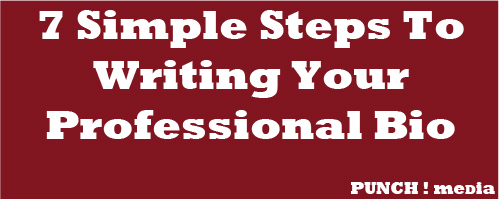7 Simple Steps To Write Your Professional Bio for Social Media

You’ve heard this saying before “You never get a second chance to make a good first impression”
It can happen in an instant.
And with Google at our fingertips – we all have access to research our connections and our potential connections.
So what does your first online impression say about you?
LinkedIn is the biggest business networking site, where your bio and resume are public for the world to see.While over 277 million people are members of this incredibly powerful site, probably 80% – 90% of people haven’t completed a proper Summary.
If you’re one of the 500 million people on Twitter, you probably take a look at the bios of the people who follow you to see if you want to follow back. What appeals to you about their profile?
Google says they are a frontrunner in the Social Media arena. Sure, they own “search” but if you register for a Gmail account, you’re automatically set up with a Google+ account. Just because you have an account, doesn’t mean everyone is using it. But if you are using Google+ there are some very interesting conversations happening. Make sure you’re not missing out on opportunities to connect with influencers and thought leaders.
Writing your professional bio is challenging. It’s time consuming. Most people don’t know what to write or how to properly express who they are and how they help their target audience.
Here are 7 simple steps that should take you from zero to hero in NO time.
Step 1: Write out at least 5 keywords that your target audience would type into Google if they were looking for someone with your skills/expertise.
Step 2: Write out at least 3 variations of words that could describe your current position and/or industry.
Step 3: What are 2 to 3 defining moments or specific events that have affected who you are today?
Step 4: Which of your personal attributes do you think have been most beneficial to you in your career?
Step 5: What makes you unique? What are some core values that make you different than anyone else?
Step 6: Who is your target audience? Who do you work with?
Step 7: How do you and your company solve their problems?
Leveraging Your Brand Story on LinkedIn
In your LinkedIn Summary, you have up to 2,000 characters to flesh out who you are, how you help your audience and effectively tell your “story”.
Ideally, you want to write it in 1st person (“I am”, instead of “John Smith is”). It’s much more personal if you’re writing directly to your target audience and they will be more likely to resonate with your copy.
You want to build trust, so write it as if you had a few moments with your perfect client in the elevator (You’ve heard of the “elevator pitch, right?).
If you can, evoke emotion. Share what makes you passionate and excited about what you do. Why do you do it? How have you made a difference? You also want your target audience to “get” what’s in it for them? What do they get when they connect with you?
Be sure to list your specialities and include those keywords to rank yourself higher when people are searching for someone with your skills.
Also create a compelling call-to-action in your Summary. What would you like people to do next? Call you? Email you? Download a white paper?
There is a whole deep dive to creating a robust profile, but this exercise just focuses on the Summary. If you’re looking for some examples, more training and a plug & play LinkedIn blueprint, click here.
Your Twitter Bio
You only have 160 characters, so you have to keep it simple. Be sure to include your city/location so people know where you are in the world (it matters).
Use effective keywords that reflect who you are. If you can, be “playful”. Twitter is a “fun” channel.
You also have an opportunity to feature a website so make it one where people can learn more about who you are.
Making Your Google Plus Profile Pop
Your tagline is supposed to be 10 words. Your Introduction seems to have no limits but you can be playful in the “bragging rights” section. People don’t have a lot of time to read a full dissertation, so again keep it short and to the point.
It’s not easy to write about yourself (I know because I’ve had to write mine too!) but you can share your accomplishments and what makes you “tick” without sounding like you’re bragging. People are expecting to see how you help them and whether they can trust you.
One final tip: Be sure to double check your work for flow and typos. If it’s someone’s first impression, you want to knock it out of the park.
And if you’re still really struggling with writing up your bio, you can contact me here or you can check out my LinkedIn Summary here.
Now it’s your turn–> What matters to you when YOU read a bio? Do you prefer professional or clever? Do you like to read about someone’s interests?

I have been struggling with writing my online bio. Your article has really helped me to focus on what’s important. Thank you!
Glad to hear the information has been helpful Jennifer. I appreciate the feedback.